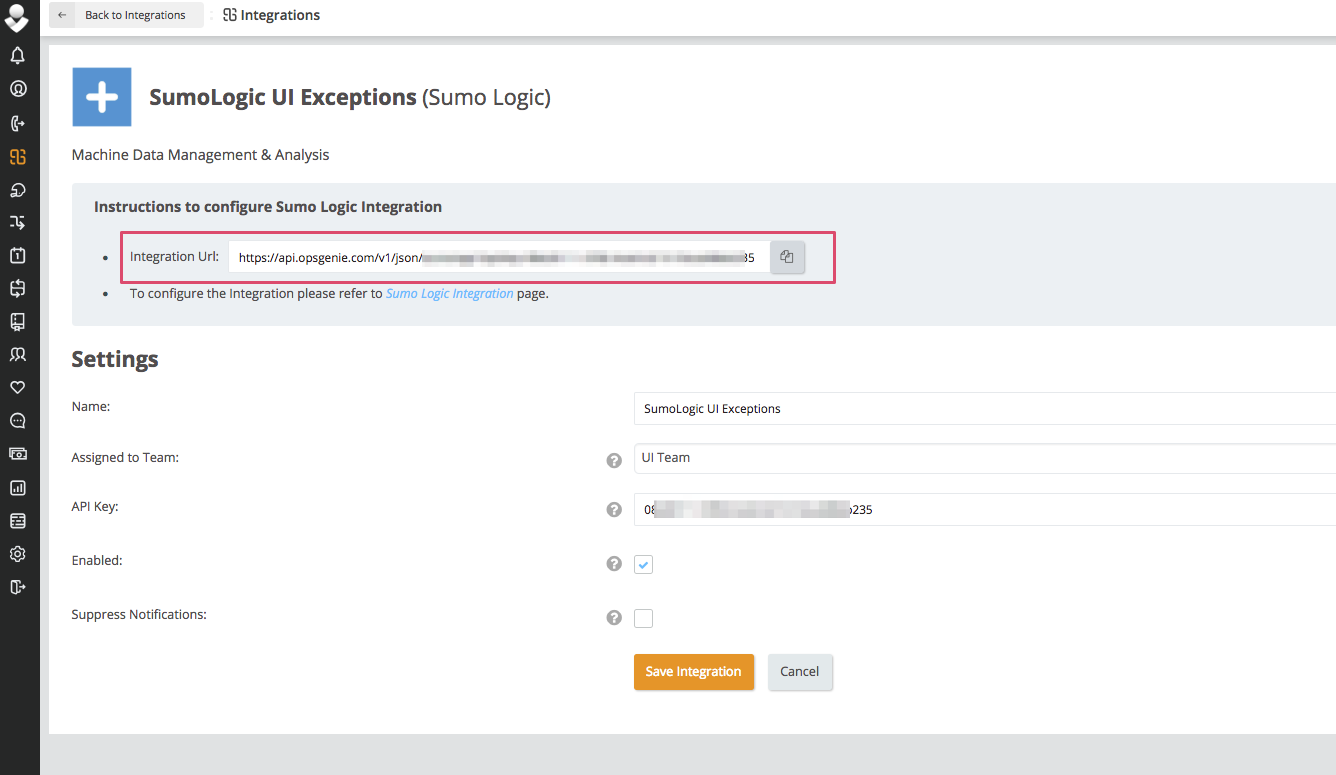Webhook Connection for Opsgenie (Legacy)

Webhook connections rely on HTTP endpoints that tell Sumo Logic where to send data. You can set up any number of connections.
Sumo Logic to Opsgenie Integration
You can monitor your infrastructure using Sumo Logic’s schedule search and send Webhook alerts to Opsgenie which manages these alerts and determines the right on-call person to notify.
To add a Sumo Logic integration in Opsgenie, do the following:
- Go to Opsgenie Integration Page.
- Specify the following parameters:
- Provide the Name.
- Add the team who will be notified of Sumo Logic Alerts.
- Copy the Integration URL, to be used in Sumo Logic while setting up the Webhook Connection.
noteFor Free and Essentials plans, you can only add the integration from the Team Dashboard. Use the alternative instructions. To add an integration directly to a team, navigate to the Team Dashboard and open the Integrations tab. Click Add Integration and search for Sumo Logic and click add.
- Click Save Integration.
Your final configurations at Opsgenie should look like this:

Configuration on Sumo Logic
In Sumo Logic, scheduled searches send alerts to other tools via webhook connections. To send alerts from Sumo Logic to Opsgenie :
Create a webhook
You need the Manage connections role capability to create webhook connections.
This section demonstrates how to create a webhook connection from Sumo Logic to Opsgenie.
To create a webhook:
- Classic UI. In the main Sumo Logic menu, select Manage Data > Monitoring > Connections.
New UI. In the top menu select Configuration, and then under Monitoring select Connections. You can also click the Go To... menu at the top of the screen and select Connections. - Click + Add and choose Webhook as connection type.
- For the name, enter Sumo Logic Opsgenie and give an optional description to the connection.
- Paste the URL (used in step 2) into the URL field.
- Enter the following content in the Alert Payload field:
note
Opsgenie uses the priority value in the Payload field to define the priority of alerts. For this reason, you should change the priority to match your needs.
{
"AlertName": "{{AlertName}}",
"Description": "{{Description}}",
"action": "create",
"AlertURL": "{{AlertResponseURL}}",
"Query": "{{Query}}",
"QueryURL": "{{QueryURL}}",
"TriggerTime": "{{TriggerTime}}",
"TriggerTimeRange": "{{TriggerTimeRange}}",
"TriggerCondition": "{{TriggerCondition}}",
"TriggerValue": "{{TriggerValue}}",
"TriggerType": "{{TriggerType}}",
"ResultsJson": "{{ResultsJSON}}",
"DetectionMethod": "{{DetectionMethod}}",
"MonitorType": "{{MonitorType}}",
"NumQueryResults": "{{NumQueryResults}}",
"SourceURL": "{{SourceURL}}"
} - To test the connection, click Test Alert. If successful, you'll see a
200 OKresponse message. - Click Save.
Configure a Scheduled Search
Scheduled searches are saved searches that run automatically at specified intervals. When a scheduled search is configured to send an alert, it can be sent to another tool using a webhook connection.
To set up a scheduled search for a webhook connection follow the steps in the Schedule Searches for Webhook Connections document.